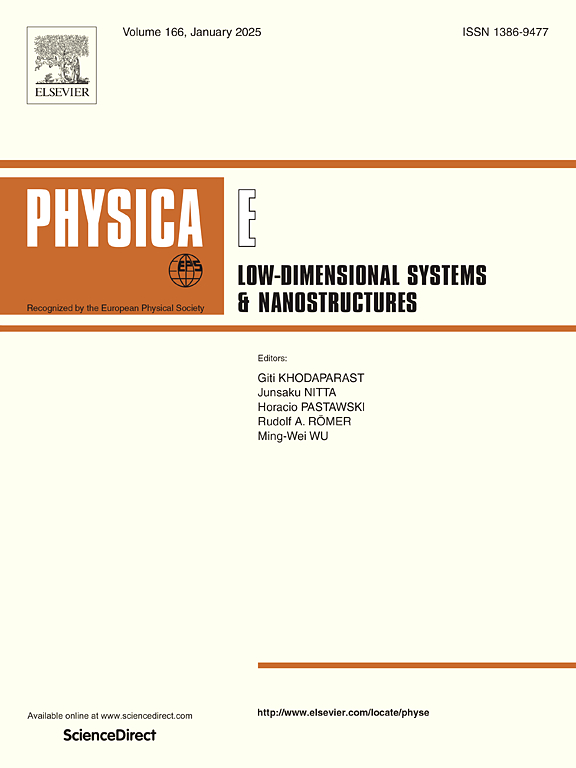Novel Janus HfMCO2 (M= Cr, Mo, Fe, Nb, Sc, Ta, Ti, V, W, Y and Zr) MXene: Promising candidates for electrode of supercapacitor
IF 2.9
3区 物理与天体物理
Q3 NANOSCIENCE & NANOTECHNOLOGY
Physica E-low-dimensional Systems & Nanostructures
Pub Date : 2025-01-24
DOI:10.1016/j.physe.2025.116196
引用次数: 0
Abstract
Janus MXenes have received greater attention for their outstanding properties. The electronic and optical properties, effective mass and quantum capacitance of Janus HfMCO2 (M = Cr, Mo, Fe, Nb, Sc, Ta, Ti, V, W, Y and Zr) are investigated by using first-principles calculation with HSE06 functional. HfMCO2 (M = Cr, Fe, V, Y) are magnetic semiconductors. The doping of Mo, Nb, Sc, Ta, and W atoms induces the transition of Hf2CO2 from semiconductor to metal. HfCrCO2, HfScCO2, and HfVCO2 have stronger magnetism with magnetic moments. The significant larger mh∗ of HfFeCO2 indicates the smaller hole mobility in valence band and slow diffusion. The optical analysis indicates that all the systems except HfVCO2 have better conductivity than Hf2CO2, especially for HfWCO2 with ε1(0) of 14.08. The doping of Fe, Ti, Mo, W and Zr atoms drastically increases the absorption coefficient in infrared and visible regions. Janus HfMCO2 (M = Cr, Fe, Mo, Sc, Ti, V, W and Zr) are suitable for cathode electrode, while HfTaCO2 and HfYCO2 are suitable for symmetrical electrode material. Large voltage only changes the electrode types of HfWCO2 and HfYCO2 to symmetric and cathode electrodes, respectively. The electrode type of Janus HfMCO2 having mixed terminations are analyzed.
新型Janus HfMCO2 (M= Cr, Mo, Fe, Nb, Sc, Ta, Ti, V, W, Y和Zr) MXene:超级电容器电极的候选材料
Janus MXenes因其出色的性能而受到越来越多的关注。采用第一性原理计算方法研究了Janus HfMCO2 (M = Cr, Mo, Fe, Nb, Sc, Ta, Ti, V, W, Y和Zr)的电子和光学性质、有效质量和量子电容。HfMCO2 (M = Cr, Fe, V, Y)是磁性半导体。Mo、Nb、Sc、Ta和W原子的掺杂诱导了Hf2CO2从半导体向金属的转变。HfCrCO2、HfScCO2和HfVCO2的磁矩越大,磁性越强。HfFeCO2的mh *显著增大,表明其价带空穴迁移率较小,扩散速度较慢。光学分析表明,除HfVCO2外,其余体系的电导率均优于Hf2CO2,尤其是ε1(0) = 14.08的HfWCO2。Fe, Ti, Mo, W和Zr原子的掺杂大大提高了红外和可见光区的吸收系数。Janus HfMCO2 (M = Cr, Fe, Mo, Sc, Ti, V, W和Zr)适用于阴极电极,HfTaCO2和HfYCO2适用于对称电极材料。大电压仅使HfWCO2和HfYCO2的电极类型分别变为对称电极和阴极电极。分析了具有混合末端的Janus HfMCO2的电极类型。
本文章由计算机程序翻译,如有差异,请以英文原文为准。
求助全文
约1分钟内获得全文
求助全文
来源期刊
CiteScore
7.30
自引率
6.10%
发文量
356
审稿时长
65 days
期刊介绍:
Physica E: Low-dimensional systems and nanostructures contains papers and invited review articles on the fundamental and applied aspects of physics in low-dimensional electron systems, in semiconductor heterostructures, oxide interfaces, quantum wells and superlattices, quantum wires and dots, novel quantum states of matter such as topological insulators, and Weyl semimetals.
Both theoretical and experimental contributions are invited. Topics suitable for publication in this journal include spin related phenomena, optical and transport properties, many-body effects, integer and fractional quantum Hall effects, quantum spin Hall effect, single electron effects and devices, Majorana fermions, and other novel phenomena.
Keywords:
• topological insulators/superconductors, majorana fermions, Wyel semimetals;
• quantum and neuromorphic computing/quantum information physics and devices based on low dimensional systems;
• layered superconductivity, low dimensional systems with superconducting proximity effect;
• 2D materials such as transition metal dichalcogenides;
• oxide heterostructures including ZnO, SrTiO3 etc;
• carbon nanostructures (graphene, carbon nanotubes, diamond NV center, etc.)
• quantum wells and superlattices;
• quantum Hall effect, quantum spin Hall effect, quantum anomalous Hall effect;
• optical- and phonons-related phenomena;
• magnetic-semiconductor structures;
• charge/spin-, magnon-, skyrmion-, Cooper pair- and majorana fermion- transport and tunneling;
• ultra-fast nonlinear optical phenomena;
• novel devices and applications (such as high performance sensor, solar cell, etc);
• novel growth and fabrication techniques for nanostructures

 求助内容:
求助内容: 应助结果提醒方式:
应助结果提醒方式:


